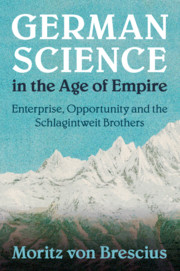Book contents
- German Science in the Age of Empire
- Science in History
- German Science in the Age of Empire
- Copyright page
- Dedication
- Contents
- Figures and Maps
- Acknowledgements
- Introduction: Empires of Opportunity
- 1 Entering the Company Service: Anglo-German Networks and the Schlagintweit Mission to Asia
- 2 Imperial Recruitment and Transnational Science in India
- 3 An Ingenious Management of Patronage Communities
- 4 Making Science in the Field: A Eurasian Expedition on the Move
- 5 The Inner Life of a ‘European’ Expedition: Cultural Encounters and Multiple Hierarchies
- 6 Contested Exploration and the Indian Rebellion: The Fateful Year 1857
- 7 The Schlagintweit Collections, India Museums and the Tensions of German Museology
- 8 Asymmetric Reputations: Memories of Exploration and German Colonial Enterprise
- Conclusion
- Archives
- Bibliography
- Index
- References
Bibliography
Published online by Cambridge University Press: 01 March 2019
- German Science in the Age of Empire
- Science in History
- German Science in the Age of Empire
- Copyright page
- Dedication
- Contents
- Figures and Maps
- Acknowledgements
- Introduction: Empires of Opportunity
- 1 Entering the Company Service: Anglo-German Networks and the Schlagintweit Mission to Asia
- 2 Imperial Recruitment and Transnational Science in India
- 3 An Ingenious Management of Patronage Communities
- 4 Making Science in the Field: A Eurasian Expedition on the Move
- 5 The Inner Life of a ‘European’ Expedition: Cultural Encounters and Multiple Hierarchies
- 6 Contested Exploration and the Indian Rebellion: The Fateful Year 1857
- 7 The Schlagintweit Collections, India Museums and the Tensions of German Museology
- 8 Asymmetric Reputations: Memories of Exploration and German Colonial Enterprise
- Conclusion
- Archives
- Bibliography
- Index
- References
- Type
- Chapter
- Information
- German Science in the Age of EmpireEnterprise, Opportunity and the Schlagintweit Brothers, pp. 367 - 400Publisher: Cambridge University PressPrint publication year: 2019

